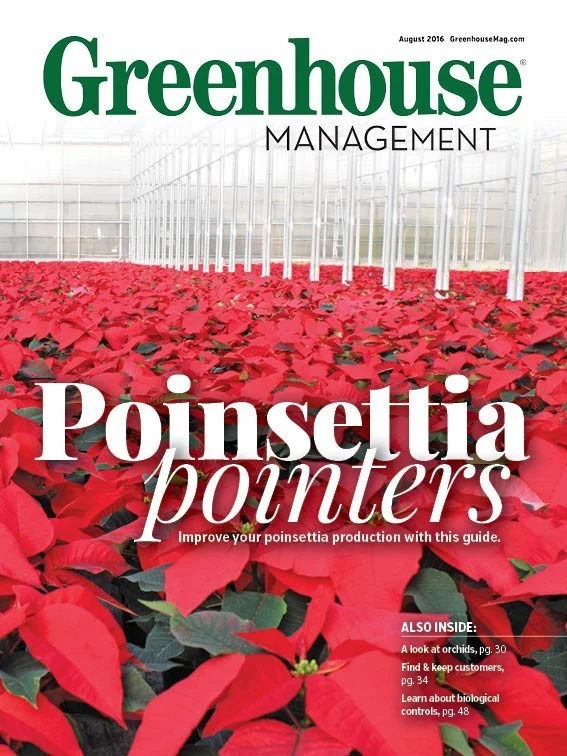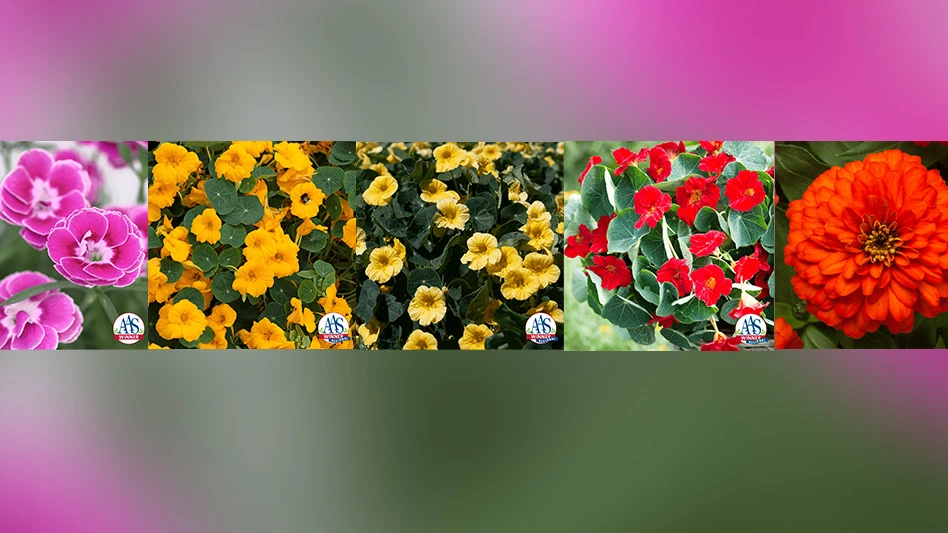Poinsettias (Euphorbia pulcherrima) are widely grown in greenhouses throughout the U.S., and like many greenhouse-grown horticultural crops, they are susceptible to a number of insect and mite pests. Therefore, it is imperative to maintain low numbers of insect and mite pests, especially before bract formation because there are very few insecticides and miticides that are labeled for poinsettia when in bract. The insect and mite pests of poinsettia can be grouped based on the plant location where they feed:
- Roots: fungus gnat larvae
- Leaves (and stems): whiteflies, western flower thrips, broad mite, Lewis mite and mealybugs
- Bracts: western flower thrips
This article provides a brief description of the damage to poinsettia plants associated with each insect and mite pest and the plant protection strategies that need to be implemented in order to alleviate problems with these pests.
ROOT PESTS
Fungus gnats

Fungus gnat (Bradysia spp.) larvae (Fig. 1) feed on root hairs and small roots, thus inhibiting the ability of poinsettia plants to obtain water and nutrients. Fungus gnats are more problematic under propagation when low numbers can kill cuttings or young plants.
Control and scouting methods
Cultural:
- Avoid keeping the growing medium excessively moist.
- Remove weeds and “old growing medium” from around the production area.
- Use either pasteurized or bagged growing medium.
Scouting:
- Use yellow sticky cards for fungus gnat adults.
- Use potato wedges for fungus gnat larvae.
There are a number of insecticides commercially available that will suppress fungus gnat larval populations in the growing medium, including: insect growth regulators [e.g. pyriproxyfen (Distance/Fulcrum)], contact insecticides [e.g. chlorfenapyr (Pylon)] and microbials [Bacillus thuringiensis subsp. israelensis (Gnatrol)]. In addition, there are three natural enemies (biological control agents) that are effective against fungus gnat larvae, including: Dalotia coriaria (rove beetle), Stratiolaelaps scimitus (predatory mite), and Steinernema feltiae (beneficial nematode). These natural enemies must be released preventatively, that is, before fungus gnat larval populations reach damaging levels.
LEAF PESTS
Whiteflies

Whiteflies, including the sweetpotato whitefly (Bemisia tabaci), are still the primary insect pest of poinsettia, feeding within the vascular system (phloem sieve tubes) and subsequently removing plant fluids. In addition, the nymphs produce or exude honeydew, which is a clear, sticky liquid that serves as a substrate for black sooty mold. Whiteflies typically feed on the underside of poinsettia leaves (Fig. 2).
Control and scouting methods
Cultural:
- Remove weeds from within and around the greenhouse.
- Avoid over-fertilizing poinsettia plants with water-soluble nitrogen-based fertilizers.
- Remove leaf debris from production areas.
Scouting:
- Use yellow sticky cards to monitor for whitefly adults.
- Perform visual inspections to monitor for eggs, nymphs, and pupae.
Contact insecticides [e.g. cyfluthrin (Decathlon)], insect growth regulators [e.g. pyriproxyfen (Distance/Fulcrum)], selective feeding blockers [e.g. pymetrozine (Endeavor)], and systemic insecticides [e.g. dinotefuran (Safari)] can be used to suppress whitefly populations.
In addition, parasitoids like Eretmocerus eremicus can be released early in the production cycle to regulate whitefly populations. Furthermore, entomopathogenic (beneficial) fungi, including: Beauveria bassiana (BotaniGard), and Isaria fumosoroseus (Preferal) are effective against whiteflies when applications are made early in the crop production cycle. However, be sure to thoroughly cover leaf undersides with spray applications where all the life stages (eggs, nymphs and adults) are located.

Western flower thrips
The larvae and adults of the western flower thrips (Frankliniella occidentalis) cause direct damage to the leaves and bracts of poinsettia plants; resulting in leaf scarring and distortion (Fig. 3).
Control and scouting methods
Cultural:
- Remove heavily infested or damaged plants.
- Screen greenhouse openings if feasible.
- Remove all weeds from within the greenhouse.
Scouting:
- Use yellow sticky cards to monitor adult populations.
- Shake leaves over a white sheet of paper (8.5 x 11 inches) to detect the presence of both larvae and adults.
There are a number of insecticides that may be used on poinsettia (prior to bract formation) to suppress populations of western flower thrips; such as, spinosad (Conserve), chlorfenapyr (Pylon), pyridalyl (Overture) and abamectin (Avid). Additional insecticides that are registered for use on poinsettia include: Beauveria bassiana (BotaniGard), Isaria fumosoroseus (Preferal) and spirotetramat (Kontos). Be sure to apply insecticides early in the crop production cycle and conduct multiple applications if warranted based on information obtained from scouting.

Broad mite
The broad mite (Polyphagotarsonemus latus) is 1/100 inches long and eggs have bumps or protrusions on the surface. A 10 or 16X hand-lens is required to actually see the mites. Broad mite feeding causes distortion or deformation of the terminal leaves of poinsettia (Fig. 4). If you suspect that broad mites are responsible for the damage observed on poinsettia plants then send samples to a diagnostic clinic for verification.
Control and scouting methods
Cultural:
- Immediately remove all plants that are suspected to be or are exhibiting damage caused by broad mites.
Scouting:
- Routinely inspect plants for any visible damage as well as the presence of broad mites.
There are pesticides commercially available with miticidal activity registered for use against broad mites, including: abamectin (Avid), bifenazate + abamectin (Sirocco), chlorfenapyr (Pylon), fenpyroximate (Akari), pyridaben (Sanmite), spiromesifen (Judo), and spirotetramat (Kontos). However, these materials must be applied before damage is noticed because once damage is observed, it is generally too late.

Lewis mite
The Lewis mite (Eotetranychus lewisi) is not a common poinsettia pest problem but greenhouse growers should be aware of this mite pest. Lewis mite looks very similar to the more common twospotted spider mite (Tetranychus urticae), but is smaller. Lewis mites feed on the lower leaves and the damage they cause on poinsettia may resemble a nutritional deficiency (Fig. 5).
Control and scouting methods
Cultural:
- Remove all weeds from within the greenhouse that serve as an alternative host plant for Lewis mites.
- Avoid over-fertilizing plants with water-soluble, nitrogen-based fertilizers.
Scouting:
- Visually inspect plants for the presence of Lewis mites by focusing primarily on leaf undersides.
- Shake leaves over a white, 8.5 x 11-inch sheet of paper to determine if Lewis mites are present.
There are miticides with contact or translaminar activity (material penetrates leaf tissues and forms a reservoir of active ingredient within the leaf that provides residual activity after spray residues have dissipated) that are labeled for use against Lewis mite, as well as, certain natural enemies, including: predatory mites and the predatory midge, Feltiella acarisuga. Check miticide labels to determine those that are registered for use against Lewis mite. Furthermore, consult with your biological control supplier to determine which predatory mites should be released against the Lewis mite.

Mealybugs
Initially, mealybugs were not considered a major pest of poinsettia. However, recently they have become more of a problem. One possible reason, based on our research in the Department of Entomology at Kansas State University (Manhattan, Kan.), is that systemic insecticides may not be effective against mealybugs on poinsettia. Therefore, populations may build up and potentially displace other insect pests that are sensitive to systemic insecticides, such as whiteflies.
Mealybugs feed on the leaf underside, on the plant stem (Fig. 6) and near the base of the petioles. Similar to whiteflies, mealybugs feed within the vascular system, removing plant fluids. Mealybugs cause leaf distortion, plant stunting and wilting. In addition, they exude copious amounts of honeydew, a clear, sticky liquid that serves as a substrate for black sooty mold.
Control and scouting methods
Cultural:- Immediately remove heavily infested plants
- Avoid over-fertilizing plants with water-soluble, nitrogen-based fertilizers.
Scouting:
- Visually inspect plants to monitor for all life stages, including crawlers (nymphs) and egg-laying females.
Mealybug populations can be suppressed using contact insecticides [e.g. mineral oil (SuffOil-X)] and insect growth regulators [e.g. buprofezin (Talus)]. However, multiple applications will be required and thorough coverage of leaf undersides and plant stems is important.
BRACT PESTS
Shore flies
Shore flies are not a major insect of poinsettia because the larvae and adults do not directly cause plant damage. However, the presence of high numbers of adults can detract from overall plant appearance. In fact, shipments may be rejected that contain a horde of shore fly adults. High populations of shore flies are indicative of excessively moist conditions and abundant algae growth.

Control and scouting methods
Cultural:
- Avoid overwatering plants.
- Eliminate algae growth throughout the greenhouse.
Scouting:
- Position yellow sticky cards just above the crop canopy and check for adults on a weekly basis.
- Visually inspect plants and the growing medium for adults. Shore fly adults can be easily seen “resting” on poinsettia leaves (Fig. 7).
There are a number of insect and mite pests that attack poinsettia crops during the growing season. However, greenhouse growers can alleviate problems with these pests by implementing a multitude of plant protection strategies, including: cultural control, scouting, pesticidal and biological control. Furthermore, a strategy used by many greenhouse growers is placing yellow sticky tape (e.g. Pestrip) among a poinsettia crop, which will capture adult fungus gnats, whiteflies, western flower thrips and shore flies. The use of yellow sticky tape may be helpful in reducing insect pest populations. Always be proactive in your approach to dealing with any insect or mite pest that attacks poinsettia, which is especially critical before bract formation as the options become limited at that point.

Explore the August 2016 Issue
Check out more from this issue and find your next story to read.
Latest from Greenhouse Management
- Showing up at your horticulture business as your whole self
- Leading women of Greenhouse Management
- Leading Women of Horticulture: Katie Dubow, Garden Media Group, and Aubry Field, Lizzy Blossom
- USDA fires experts on invasive pests, including Asian citrus psyllid, chilli thrips
- Farwest Show calls for 2025 New Varieties Showcase entries
- Leading Women of Horticulture: Arden Pontasch, North Creek Nurseries
- Leading Women of Horticulture: Emily Showalter, Willoway Nurseries
- Leading Women of Horticulture: Anna Ball, Ball Hort, and Terri McEnaney, Bailey Nurseries





